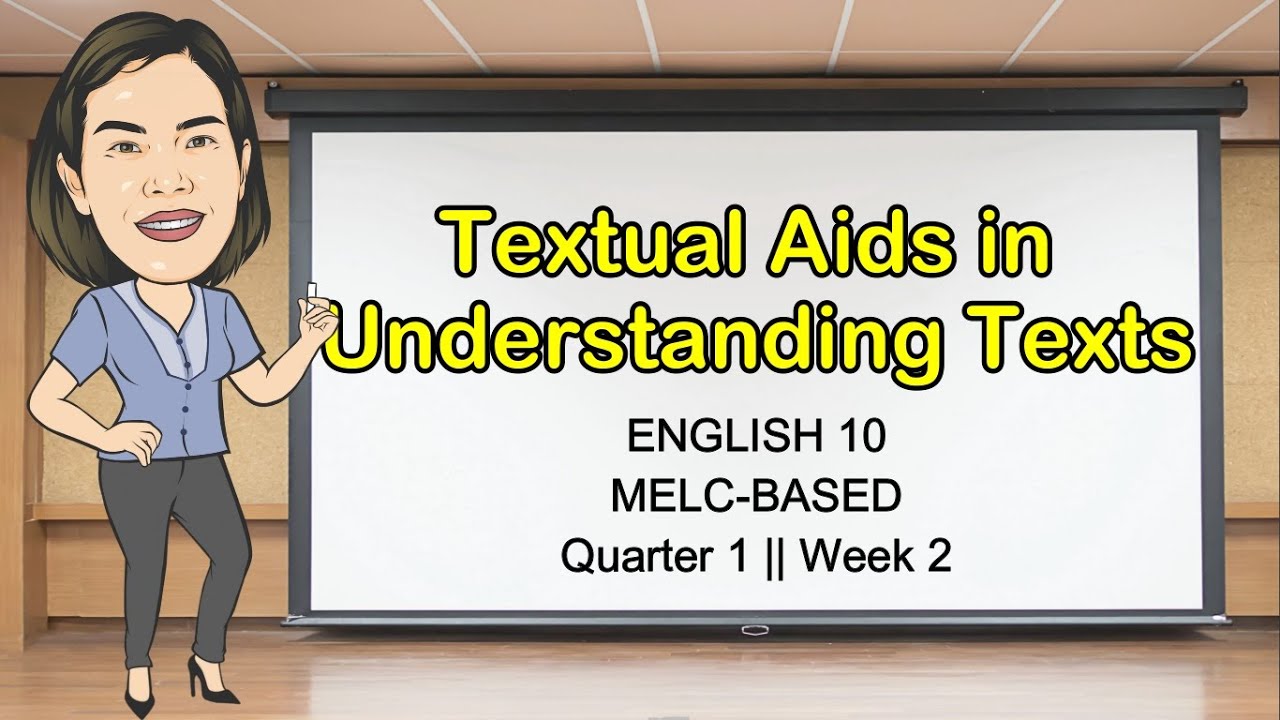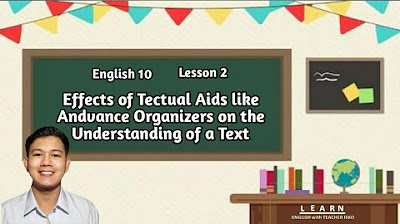Grade 10 English Q1 Ep4: Textual Aids
Summary
TLDRThe video script features Carla, an English teacher, guiding Grade 10 students through a lesson on textual aids, such as flow diagrams, pie graphs, and Ishikawa diagrams. Using relatable examples, Carla teaches how to identify and apply various textual aids to simplify the comprehension of data. She also emphasizes the distinction between linear and non-linear texts and explains how to transcode between them. The lesson is interactive, with quizzes and real-life applications, designed to enhance understanding while making learning enjoyable.
Takeaways
- 📊 The script teaches students about different types of textual aids such as flow diagrams, pie charts, and bar graphs to simplify comprehension.
- 🎯 A flow diagram is used to show the sequence of events or steps in a process.
- 📝 A graphic organizer is a tool for visual displays of key content and concepts.
- ⚖️ A Venn diagram is used to highlight similarities and differences between two or more subjects.
- 🐟 A fishbone diagram, also known as the Ishikawa diagram, helps identify the root causes of an issue.
- 📈 A bar graph represents numerical data using bars and is commonly used in financial analysis or tracking consumption, like electricity usage.
- 🥧 A pie graph shows proportional data, like how someone spends their weekend, using colorful pie slices to represent percentages.
- 📚 A pictograph uses images to represent data, making it visually engaging and easier to understand at a glance.
- 📚 Linear text is a traditional type of text that is read sequentially from beginning to end, while non-linear text uses aids like charts and diagrams.
- 🧠 Using cause-and-effect diagrams helps connect concepts and understand the factors influencing events, like speech anxiety in students.
Q & A
What is a flow diagram, and where is it commonly used?
-A flow diagram is a sequence chart that shows the order of a series of events or steps in a process. It is commonly used to illustrate processes and procedures in a logical, step-by-step manner.
What is the purpose of a graphic organizer?
-A graphic organizer is a visual display that organizes information and concepts, helping to simplify complex ideas. It allows students to see relationships between different pieces of information.
How does a cause-and-effect diagram work, and what is its purpose?
-A cause-and-effect diagram, also known as an Ishikawa or fishbone diagram, is used to visually represent the relationship between a problem (effect) and its potential causes. It helps identify and organize various factors contributing to an issue.
Who was Kaoru Ishikawa, and what is his contribution to organizational theory?
-Kaoru Ishikawa was a Japanese organizational theorist who popularized the cause-and-effect diagram (Ishikawa diagram) in the 1960s. His work has had a significant influence on quality management and process improvement techniques.
What is a bar graph, and how is it used?
-A bar graph is a chart that plots numerical data using bars or columns to show the total amount of interpretations for a certain category. It is commonly used in financial evaluations, such as tracking electricity consumption over time.
What are the key parts of a bar graph?
-The key parts of a bar graph include the title (which explains what the graph is about), labels (that show the type of data being presented), and the scale (numbers that indicate the amount represented by each bar).
How is a pie graph used, and what does it represent?
-A pie graph is a special chart that uses slices of a pie to represent proportional data. Each slice corresponds to a percentage of the whole, making it useful for illustrating comparative sizes of data, such as time spent on different activities.
What is a pictograph, and why is it effective?
-A pictograph represents data using images or symbols instead of words or numbers. It is effective because it conveys large amounts of information in a visually engaging way, making it easier to understand at a glance.
What is the difference between linear and non-linear text?
-Linear text follows a sequential path from beginning to end, focusing on grammar and style, commonly seen in novels and letters. Non-linear text does not require sequential reading and includes charts, diagrams, and graphical organizers that allow for more flexible interpretation of information.
How can transcoding be applied when converting a linear to non-linear text?
-To transcode a linear to non-linear text, one should follow steps such as extracting the main idea, using keywords or phrases, classifying information into categories, and selecting the correct non-linear format (e.g., a chart or diagram) to represent the information visually.
Outlines

Этот раздел доступен только подписчикам платных тарифов. Пожалуйста, перейдите на платный тариф для доступа.
Перейти на платный тарифMindmap

Этот раздел доступен только подписчикам платных тарифов. Пожалуйста, перейдите на платный тариф для доступа.
Перейти на платный тарифKeywords

Этот раздел доступен только подписчикам платных тарифов. Пожалуйста, перейдите на платный тариф для доступа.
Перейти на платный тарифHighlights

Этот раздел доступен только подписчикам платных тарифов. Пожалуйста, перейдите на платный тариф для доступа.
Перейти на платный тарифTranscripts

Этот раздел доступен только подписчикам платных тарифов. Пожалуйста, перейдите на платный тариф для доступа.
Перейти на платный тарифПосмотреть больше похожих видео

TEXTUAL AIDS IN UNDERSTANDING TEXTS || Quarter 1 Week 2 || English 10 || MELC-BASED || Aizie Dumuk

Grade 10 English Q1 Ep3: Textual Aids in Understanding Text

Textual Aids - English 10 - Lesson 2

Statistik#1 : Diagram | Kelas X Fase E Kurikulum Merdeka

Kurikulum Merdeka Materi Matematika Kelas 7 Bab 6 Data dan Diagram

LOMBA VIDEO INOVASI PEMBELAJARAN / BEST PRACTICE / INOBEL / VIDEO PRAKTIK BAIK
5.0 / 5 (0 votes)
